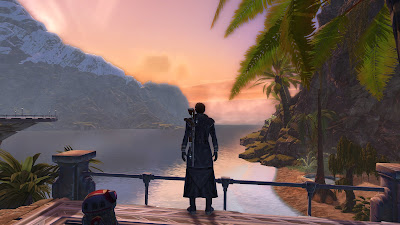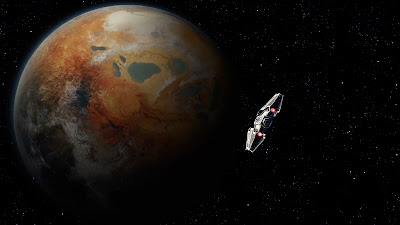Bhagpuss recently put up an interesting post about Wuthering Waves that got me thinking about storytelling in MMOs, and the Lord of the Rings Online specifically. I have started playing LoTRO again mainly because I was forced to. The 32 bit servers are going to be permanently closed some time in August, and since LoTRO is one of my most played games I didn't want to lose all of my characters. After updating the client on a new PC that I recently migrated to, I transferred all my characters to one of the new 64 bit servers: Peregrine. That's the North American roleplay server. I figured most of the serious Tolkien lore grognards would move there, as so far World Chat has certainly not disappointed on that count.
The process of moving was painless. I clicked one button to select all the characters on Arkenstone, and by the time I logged out and back in to my new server everyone was there. Perhaps even more miraculous, nothing appears to be missing from their banks and all of my character names save one were still available. However, of course, the name of my level 100 main "Silene" was taken.* I had to switch her to "Sileeyn," which still slightly annoys me when I glance at her on the character select screen.
The last time I was playing it heavily I remembered quite liking the storytelling. But over the years (it's been about four since I last logged), I had started to become skeptical of the stories being all that well done, and thought maybe it was just rosy goggles talking. I mean they are presented solely as flat text, and it's not uncommon to have several quests all pointing you towards killing boars, or bears, or bandits in the exact same zone. How entertaining could six quests in row about killing boars really be? And how could a flat text presentation compare to the voice acting in Secret World, or the full voice acting and branching storylines of SWTOR?
Now that I have played it again for a few evenings, I remember why I liked it so much. It's because a lot of the stories work on two completely different levels. On the surface they are entertaining stories on par with the better ones from say, EQ II or ESO. You get a strong sense of the personality of everyone you interact with, and many of the hobbit stories make me smile. For example, there is an NPC ranting in the town square of Michel Delving about a conspiracy to deny equal access to the best pie fillings to everyone in the Shire, with the uppity Tooks hoarding all the freshest ingredients. Both the impassioned speech and the very funny responses from other hobbits standing nearby just ooze with the same charm as a lot of what Tolkien himself wrote about hobbits.
But if you only appreciate the game based strictly on what is presented, a lot of what is on offer isn't really exceptionally well done. Even World of Warcraft has some quests telling stories just as well written, and I don't consider that a particularly good MMO for narratives (just the opposite in many cases). I wouldn't be surprised for anyone that isn't a fan of Tolkien to have the exact same reaction as Bhagpuss: "LotRO to me is just a lot of meaningless fetch and kill quests strung together. Which, honestly, is no bad thing in terms of gameplay but does absolutely nothing for me in terms of telling a story."
It's really the second level the stories work on that elevates them. In addition to being competent and at having text prose that is at least (but perhaps only) slightly above average for the genre, many of the stories are also filling in little details from the books in a way that is quite well done and satisfying. For example, if you are familiar with Unfinished Tales, you know that Saruman was smuggling pipe weed out of the Shire and trying to keep it secret from Gandalf and the other members of the white council. In public he ridiculed Gandalf for smoking it, and was too embarrassed to admit that he too enjoyed the stuff once he got around to trying it. Gandalf knew that Saruman was sneaking it out of the Shire, but just assumed that Saruman being so secretive about it was a bit of harmless vanity. In any case, at the end of an entertaining six step quest chain, you stumble on his smuggling operation and even get to read a note from "Sharkey" to his agents.**
That's just one example, a lot of neat details like that get filled in by quests in the game. The writers use Tolkien's fiction like wooden frame that they fill in with a building paying homage to the work it draws upon. As delightful as I find this element, I think it also explains why a lot of players don't actually find the storytelling as compelling as I do in LoTRO. I personally would put it right up there with Secret World and SWTOR as some of the most solid storytelling you will find in a multiplayer game. However, I have to think a lot of players don't recognize most of the callbacks to the source material.
Unfortunately, you can't really appreciate the stories on both levels unless you are intimately familiar with the Lord of the Rings, including the Appendices of LoTR, the Hobbit and at the very least Unfinished Tales. Knowing the Silmarillion and the newer compilations collected by Christopher Tolkien and others doesn't hurt a bit. For example, many of the stories set in Near Harad are actually rooted in brief notes about how Númenorians colonized the region in the second age, and a civil war between the Northern and Southern Kingdoms of Gondor during the third age. To really fully appreciate some of what you see in those regions, you likely need to have read the Silmarillion, the Appendices, and the Fall of Númenor. Some of the latter material has never been published previously save in the twelve volume History of Middle Earth. I consider myself a pretty hardcore Tolkien nerd, but twelve volumes of apocrypha is way too much even for me. Regardless, it's clear the game relies heavily on a player being a fan of the IP to "pop", which in the end almost certainly reduces their audience.***
This also raise a more general question in my mind: can you consider storytelling good if only those deeply versed in something outside of what is being presented can fully appreciate it? I am of two minds about it. On the one hand, there is a school of thought that for art to be "good" in some kind of objective sense, it must be enjoyable for almost anyone that takes the time to really consider it. For example, during the Classical period composers intentionally simplified their compositions compared the Baroque composers that preceded them. This was in part because Baroque compositions were considered too complex, and too difficult to appreciate for a typical listener. The Classical composers wanted their compositions to be more accessible to a wider audience. As my music appreciation professor explained it when I was an undergrad, the idea was that nearly any sane person should be able to enjoy the compositions. This is sometime referred to as part of the classical ideal of universality.*!*
On the other hand, that kind of thinking is one step away from arguing that only the simplest pop art has any real value. In my experience, if you are patient enough, art (by which I mean to include visual, written, musical or even game formats that combine all three at once) that makes you work a little bit to appreciate it tends to have a lot more staying power than something you can fully appreciate the first time you experience it. I'm not sure myself where I draw the line between needless pretension or absurd "homework" expectations and art that I find complex and thought provoking. But for me personally LoTRO is definitely on the correct side of that line, and I'll take Bach or Stravinsky over Mozart any day of the week :-)**!*
*According to the character creation screen in LoTRO, female hobbits often have flower inspired names. Silene is a genus of flowering plants, and I thought it sounded neat for a hunter that might be expected to take out foes before they even know she is there.
**That is the same pseudonym that Saruman uses much later when he scours the Shire in the Lord of the Rings books.
***The first thing I posted here that got any traction was a designed to help you decide whether the game might be for you, and to poke some gentle fun at a few people that not only didn't enjoy the game much but actually seemed actively offended that the game dared to exist. It's been a long time since the game has been visible enough to attract that kind of attention, which is in at least some ways better for all involved.
*!*It was way harder than I expected it to be to find a good reference to back up what I remembered from that music appreciation course I took over 20 years ago. In my experience, Gemini is often making Google worse for really specialized searches. It seems to now answer what it assumes you mean to ask rather than what you actually type. I had to use three different sets of search terms get to that link, and it's still a bit off from what I had in mind.
**!*Except for Requiem, that's awesome.





















